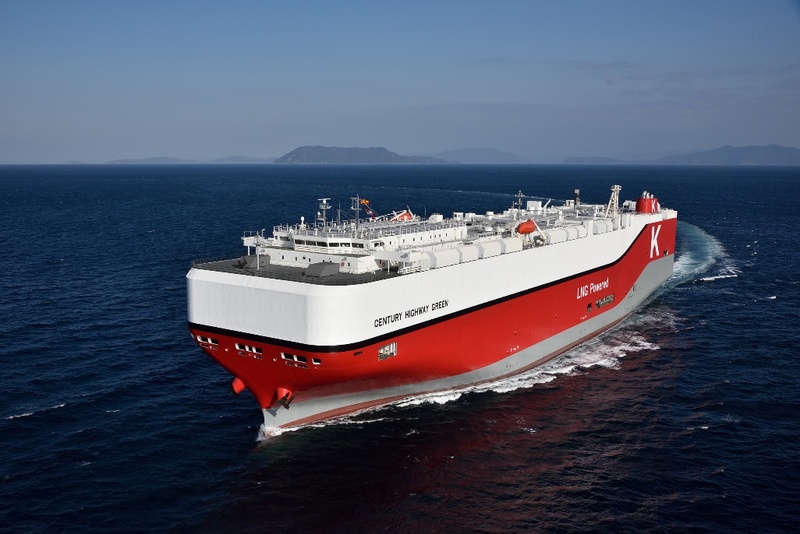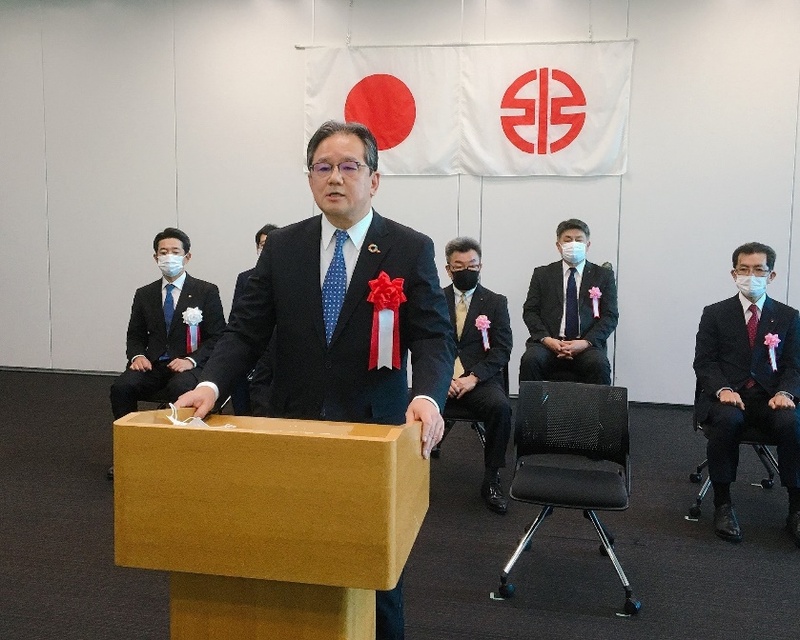On March 12, the “CENTURY HIGHWAY GREEN”, a car carrier fueled by LNG (liquefied natural gas) that had been under construction at Tadotsu Shipyard Co., Ltd., part of the Imabari Shipbuilding Group, has been delivered to “K” LINE.
She is a next-generation environmentally friendly vessel expected to reduce emissions of carbon dioxide (CO2), which is a greenhouse gas (GHG) by 25% to 30%(*1), emissions of sulfur oxides (SOx), which cause air pollution, by almost 100%, and emissions of nitrogen oxides (NOx) by 80% to 90% with the use of Exhaust Gas Recirculation (EGR) in addition to the use of LNG fuel, compared to conventional vessels using heavy fuel oil. The launch of “K” LINE’s first LNG-fueled car carrier realizing transportation with a low environmental impact is an important milestone for achieving the targets set forth in the “K” LINE Environmental Vision 2050(*2).
In addition, a remote naming ceremony was carried out on March 3, ahead of the vessel’s delivery. Four locations in Aichi, Kagawa, Okayama, and Tokyo were connected online, with attendees including Toyota Motor Corporation (head office: Toyota-city, Aichi; President and Representative Director: Akio Toyoda) Chairman and Representative Director Takeshi Uchiyamada and his wife, Ministry of Land, Infrastructure, Transport and Tourism Maritime Bureau Director-General Shinichiro Otsubo, Ministry of the Environment Chugoku-Shikoku Regional Environmental Office Director Kenji Kamita, Imabari Shipbuilding Co.,Ltd. President Yukito Higaki and “K” LINE President and Representative Director Yukikazu Myochin. The vessel was named by adding the word “GREEN” evoking images of harmony with the planet and the environment to the traditional name of “CENTURY HIGHWAY” that has been used in four of “K” LINE’s car carriers in the past.
The vessel utilizes a variety of environmental measures and digital technologies in an effort to improve safety, environment, and quality that are important issues for “K” LINE.
Overview of the Vessel:
LOA: 199.98 meters;
Beam : 37.2 meters;
Maximum number of cars loaded : 7,080 vehicles;
Gross tonnage : 73,515 tonnes;
LNG fuel tank capacity : 2,439 cubic meters
Registry: Japan
Environmental Specifications of the Vessel:
The vessel uses a dual fuel main engine and auxiliary engines (generator, boiler) capable of operating on either LNG or Marine Gas Oil (MGO). The main engine uses a high-pressure type ME-GI engine, reducing emissions of methane slip (unburnt gas), which is a greenhouse gas.
The main engine utilizes EGR and the generator utilizes Selective Catalytic Reduction (SCR), clearing NOx Tier III regulations when using either LNG and MGO fuel.
The construction of the vessel received support of the “Model Project for Measures to Reduce Emissions of CO2 from Vessels Utilizing Alternative Fuels” that is a joint project by the Ministry of the Environment and the Ministry of Land, Infrastructure, Transport and Tourism.
Part of the construction funding for the vessel was procured from Mizuho Bank, Ltd. and Sumitomo Mitsui Trust Bank, Limited through Japan’s first climate transition loans.
"K" Line takes delivery of next-generation LNG fueled car carrier “CENTURY HIGHWAY GREEN”
A remote naming ceremony was carried out on March 3, ahead of the vessel’s delivery
On March 12, the “CENTURY HIGHWAY GREEN”, a car carrier fueled by LNG (liquefied natural gas) that had been under construction at Tadotsu Shipyard Co., Ltd., part of the Imabari Shipbuilding Group, has been delivered to “K” LINE.
She is a next-generation environmentally friendly vessel expected to reduce emissions of carbon dioxide (CO2), which is a greenhouse gas (GHG) by 25% to 30%(*1), emissions of sulfur oxides (SOx), which cause air pollution, by almost 100%, and emissions of nitrogen oxides (NOx) by 80% to 90% with the use of Exhaust Gas Recirculation (EGR) in addition to the use of LNG fuel, compared to conventional vessels using heavy fuel oil. The launch of “K” LINE’s first LNG-fueled car carrier realizing transportation with a low environmental impact is an important milestone for achieving the targets set forth in the “K” LINE Environmental Vision 2050(*2).
In addition, a remote naming ceremony was carried out on March 3, ahead of the vessel’s delivery. Four locations in Aichi, Kagawa, Okayama, and Tokyo were connected online, with attendees including Toyota Motor Corporation (head office: Toyota-city, Aichi; President and Representative Director: Akio Toyoda) Chairman and Representative Director Takeshi Uchiyamada and his wife, Ministry of Land, Infrastructure, Transport and Tourism Maritime Bureau Director-General Shinichiro Otsubo, Ministry of the Environment Chugoku-Shikoku Regional Environmental Office Director Kenji Kamita, Imabari Shipbuilding Co.,Ltd. President Yukito Higaki and “K” LINE President and Representative Director Yukikazu Myochin. The vessel was named by adding the word “GREEN” evoking images of harmony with the planet and the environment to the traditional name of “CENTURY HIGHWAY” that has been used in four of “K” LINE’s car carriers in the past.
The vessel utilizes a variety of environmental measures and digital technologies in an effort to improve safety, environment, and quality that are important issues for “K” LINE.
Overview of the Vessel:
LOA: 199.98 meters;
Beam : 37.2 meters;
Maximum number of cars loaded : 7,080 vehicles;
Gross tonnage : 73,515 tonnes;
LNG fuel tank capacity : 2,439 cubic meters
Registry: Japan
Environmental Specifications of the Vessel:
The vessel uses a dual fuel main engine and auxiliary engines (generator, boiler) capable of operating on either LNG or Marine Gas Oil (MGO). The main engine uses a high-pressure type ME-GI engine, reducing emissions of methane slip (unburnt gas), which is a greenhouse gas.
The main engine utilizes EGR and the generator utilizes Selective Catalytic Reduction (SCR), clearing NOx Tier III regulations when using either LNG and MGO fuel.
The construction of the vessel received support of the “Model Project for Measures to Reduce Emissions of CO2 from Vessels Utilizing Alternative Fuels” that is a joint project by the Ministry of the Environment and the Ministry of Land, Infrastructure, Transport and Tourism.
Part of the construction funding for the vessel was procured from Mizuho Bank, Ltd. and Sumitomo Mitsui Trust Bank, Limited through Japan’s first climate transition loans.






